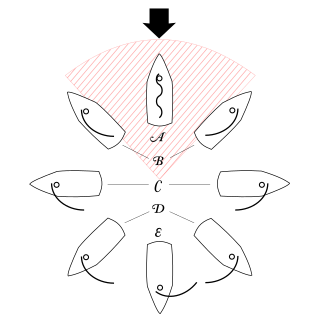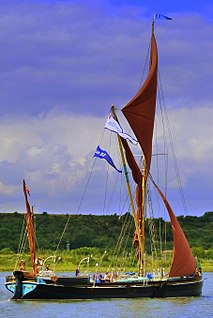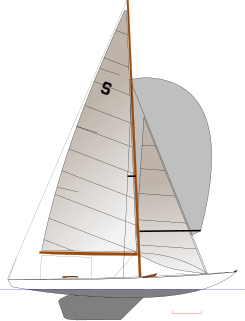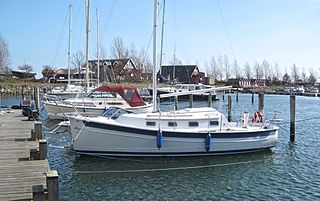 | |
| Genre | Clothing manufacturer |
|---|---|
| Founded | 1973 |
| Founder | Nick Gill |
| Headquarters | , United Kingdom |
| Website | www |
Gill is the trade name of Douglas Gill International, [1] a sailing wear company based in England. [2]
 | |
| Genre | Clothing manufacturer |
|---|---|
| Founded | 1973 |
| Founder | Nick Gill |
| Headquarters | , United Kingdom |
| Website | www |
Gill is the trade name of Douglas Gill International, [1] a sailing wear company based in England. [2]
Gill was founded in 1973 by Nick Gill, a British dinghy sailor who sailed in the National 12 class, within his father's already established business. [3] YFM Equity Partners purchased the company from Nick Gill in 2013, [4] and, in 2018, the company acquired Gill North America Ltd., the leading marine brand in the United States, Canada, Mexico and the Caribbean, previously operated independently under a distribution agreement. [5]

Sailing employs the wind—acting on sails, wingsails or kites—to propel a craft on the surface of the water, on ice (iceboat) or on land over a chosen course, which is often part of a larger plan of navigation.

Windsurfing is a surface water sport that is a combination of surfing and sailing. It is also referred to as "sailboarding" and "boardsailing", and emerged in the late 1960s from the surf culture of California. Windsurfing had gained a following across North America by the late 1970s and had achieved significant global popularity by the 1980s.
A tack is a nautical term both for the lower, windward corner of a sail and, separately, for the side of a sailing craft from which the wind is coming while under way—the starboard or port tack. A boat is on a starboard tack if the wind is coming over the starboard (right) side of boat with sails on port (left) side. Similarly, a boat is on a port tack if the wind is coming over the port (left) side of boat.

A point of sail is a sailing craft's direction of travel under sail in relation to the true wind direction over the surface.

The Laser is a widely used class of single-handed, one-design sailing dinghies using a common hull design with three interchangeable rigs of different sail areas, appropriate to a given combination of wind strength and crew weight. Bruce Kirby designed the Laser in 1970 with an emphasis on simplicity and performance.

World Sailing (WS) is the world governing body for the sport of sailing recognized by the International Olympic Committee and the International Paralympic Committee (IPC).

The 470 (Four-Seventy) is a double-handed monohull planing dinghy with a centreboard, Bermuda rig, and centre sheeting. Equipped with a spinnaker, trapeze and a large sail-area-to-weight ratio, it is designed to plane easily, and good teamwork is necessary to sail it well. The name comes from the boat's length of 470 centimetres.

The Optimist, also known as the ‘opti’, or 'oppie', is a small, single-handed sailing dinghy intended for use by children and teenagers up to the age of 15. Contemporary boats are usually made of fibreglass, although wooden boats are still built.

The Yngling is a sailboat that was designed by Norwegian Jan Herman Linge as a one design racer and first built in 1967.

A full-rigged ship or fully rigged ship is a sailing vessel's sail plan with three or more masts, all of them square-rigged. A full-rigged ship is said to have a ship rig or be ship-rigged. Such vessels also have each mast stepped in three segments: lower mast, top mast, and topgallant mast. Other large, multi-masted sailing vessels may be regarded as ships while lacking one of the elements of a full-rigged ship, e.g. having one or more masts support only a fore-and-aft sail or having a mast that only has two segments.

The International 420 Dinghy is a sailing dinghy popular for racing and teaching. The hull is fiberglass with internal buoyancy tanks. The 420 has a bermuda rig and an optional spinnaker and trapeze. It has a large sail-area-to-weight ratio, and is designed to plane easily. It can be rigged to be sailed single-handed or double-handed. The 420 is an International class recognized by World Sailing. The name refers to the boat's length of 420 centimetres.

A Thames sailing barge is a type of commercial sailing boat once common on the River Thames in London. The flat-bottomed barges with a shallow draught and leeboards, were perfectly adapted to the Thames Estuary, with its shallow waters and narrow tributary rivers. The larger barges were seaworthy vessels, and were the largest sailing vessel to be handled by just two men. The average size was about 120 tons and they carried 4,200 square feet (390 m2) of canvas sail in six working sails. The mainsail was loose-footed and set up with a sprit, and was brailed to the mast when not needed. It is sheeted to a horse, as is the foresail; they require no attention when tacking. The foresail is often held back by the mate to help the vessel come about more swiftly.

The Fireball is a British sailing dinghy that was designed by Peter Milne as a one-design racer and first built in 1962.

Poul Richard Høj Jensen "PRHJ" is a Danish sailor, boatbuilder, sailmaker and Olympic champion. PRHJ lives with his wife Sophia alternating in Burnham on Crouch and Freetown, Antigua and Barbuda.

The RS600 is a sailing dinghy designed by Clive Everest and Nick Peters and supplied by RS Sailing. It is now built by the Boatyard at Beer. It is a single hander with trapeze and racks. It has a Portsmouth Yardstick of 916 and a D-PN of 76.2.
The RS700 is a single-handed racing dinghy built by RS Sailing and designed in 2000 by Nick Peters and Alex Southon as part of the RS series and built in 2001. It is raced in many sailing clubs around Britain, with a PY number of 850 and a D-PN of 73.3.

The Swallow is a type of one-design classic keelboat that was used as a two-man Olympic class for the 1948 Olympics. It is now sailed with three crew. Now a thoroughly modern classic, the main fleet is at Itchenor in Chichester Harbour, West Sussex, with a smaller fleet at Aldeburgh, Suffolk. There are around 40 active boats. As a National Class, the rules and affairs of the Class are regulated by the Royal Yachting Association. Many of these boats are named after birds and, in particular, sea birds.

SB Cambria is a preserved spritsail Thames sailing barge now used for sail training. She was the last barge to trade entirely under sail, and took her last cargo in 1970. She is now restored and owned and operated by the Cambria Trust, a registered charity under English law.

The Topaz Vibe is a British sailing dinghy designed by Ian Howlett and Rob White. Built by Topper International, it was first introduced in 2006. There are two models, the Vibe and the Vibe X, with the latter carrying larger sails. The Vibe is a World Sailing Learn to Sail class.

The Seaward 25 is an American trailerable sailboat that was designed by Nick Hake a cruiser and first built in 1984.